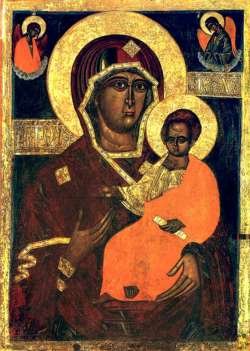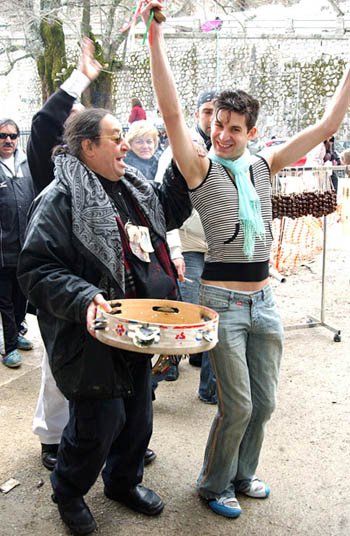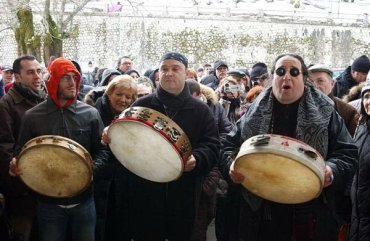Montevergine
Black Madonna di Montevergine
Madonna di Montevergine
Madonna di Constantinopoli
Madonna Bruna (the brown Madonna)
Mamma Schiavona (slave mama)
In her sanctuary, a Benedictine abbey, on Mount Partenio (1,493 meters high), Province Avellino, 56 km East of Naples. In the charming medieval town of Mercogliano you catch the “funicular” or “cob train” that climbs a breath-taking slope in 7 minutes. (Or you can drive a winding road all the way up.) Open 6 a.m. to 8 p.m., painting on pine wood 460 x 230 cm, probably around 1290 A.D. though according to local legend the face was painted by St. Luke the evangelist and seems to actually stem from the 5th century.
Content:
The Icon
The Sanctuary
Why “Slave Mama”?
The Festival
Gays at Montevergine, or Sex and the Goddess
The Icon
This is one of quite a few Black Madonnas that are attributed to Luke the Evangelist. Tradition says he painted only the head of Mary, which was later fitted into the larger icon. The whole is considered a “Hodegetria” type of Madonna, i.e. “she who points the way” or “the guide”, so called because her right hand points at Jesus as the way to salvation. While the Virgin of Montevergine isn’t actually in the classical Hodegetria pose, she is nonetheless known as the Hodegetria of Constantinople.
Tradition recounts that Eudocia (c. 401-460), the wife of the Byzantine Emperor Theodosius II, brought Saint Luke’s original portrait of the Virgin from Palestine to Constantinople. There it was fitted into a very large icon of Mary and Jesus and greatly revered with weekly ceremonies described thus:
A 16th century copy of the Hodegetria of Smolensk. This is the typical Hodegetria gesture.
"Every Tuesday twenty men come to the church of Maria Hodegetria; they wear long red linen garments, covering up their heads like stalking clothes ... there is a great procession and the men clad in red go one by one up to the icon; the one with whom the icon is pleased is able to take it up as if it weighed almost nothing. He places it on his shoulder and they go chanting out of the church to a great square, where the bearer of the icon walks with it from one side to the other, going fifty times around the square. When he sets it down others take it up in turn." Another account says, as the bearers staggered around the crowd, the icon seemed to lurch towards onlookers, who were then considered blessed by the Virgin. Clergy touched pieces of cotton-wool to the icon and handed them out to the crowd. The image was double-sided, with the crucifixion of Jesus on the other side.¹ This makes sense if it was painted for processions.
While the Polish people claim the Hodegetria of Constantinople ended up at Czestochowa, and the Russians believe it to be their "Hodegetria of Smolensk", destroyed during the German occupation in 1941, the Italians maintain that their Mama Schiavona of Montevergine is the original first Black Madonna painted by St. Luke.
As it turns out they may almost be right. The original sacred image disappeared during the fall of Constantinople in 1453, but this one may actually be the oldest, still extant Western copy of it. At least that’s what Margherita Guarducci, an illustrious scholar of art history and archaeology claims. She investigated the famous Slave Mama of Montevergine in the 1990’s using newest technology.² It turns out that the bust was painted over several times and previous analyses could only reach down to the layer that was created in the 13th century. But now Guarducci discovered another, deeper layer painted on linen burlap with a type of paint that was used in the 5th century.
But back to the capital of the East-Roman Empire: Italian traditions say that as the last Latin Emperor of Constantinople, Baldwin II, was escaping the besieged city in 1261, he took the head of the icon (the part attributed to Luke) with him. Later it came into the possession of the Angevin dynasty, the House of Anjou, who had it inserted again into a much larger image of Mary and the Christ child. Around the year 1300 they gave the icon to the sanctuary on Montevergine.
The Sanctuary
As so many Black Madonna sanctuaries, so this one too started out as a Pagan holy site dedicated to the goddess Cybele. Tradition says that in the early 11th century, when Paganism was still practiced in remote parts of Europe, St. William of Vercelli, the patron saint of Irpinia, decided to turn this mountain shrine to Cybele the Great Mother of the Gods, into a sanctuary of Mary the Most Holy Mother of God. He gathered a little band of monks around him and occupied the place for Christianity. The first real church was consecrated in 1124. It was destroyed and rebuilt several times. The current monastery, guest house, and sanctuary date from between the 18th and 20th centuries. Architecturally they are not very interesting, but the basilica is richly decorated and the whole place lies in breathtaking scenery.
Why “Slave Mama”?
Why is this Black Madonna, along with some of her other Italian sisters, called Slave Mama? Because in the mind of old time Italians her dark complexion marked her as one of the serving class, the Mother of all Slaves. An old folk song recounts how the Madonna of Montevergine was ashamed that her dark skin made her look like a slave. It made her the ugliest of the “six sisters” (six famous Madonnas in the Campania region)³. So she hid her face on this mountain. But lo and behold, the song concludes, this Brown Mama turned out to be the most miraculous and hence the most beautiful of them all.
The local peasants love their Slave Mama more than any other Madonna because she is the mother of all those who are chained to hard work. She understands their plight. As another folk song says: “You alone lighten our chains, the chains to hard work, a thousand years of hard work and thousands of sweats".⁴
To the more politically minded (and there are many of those in Italy) the divine Slave Mama is also the mother of all who are oppressed or outcast, including gays. Lucia Chiavola Birnbaum elucidates the link between Italian Communists and their love for Black Madonnas in her book "Black Madonnas: Feminism, Religion, and Politics in Italy".⁵
The Festival
Every year the Madonna of Montevergine is honored with a grand two part festival, which opens on February 2nd, the “purification of the Virgin” during Candlemas, and closes on September 8th, the birthday of Mary (or on the closest Sunday to it). The events draw thousands of faithful and the stream never stops. All together about two million pilgrims come to Montevergine every year. They couldn’t be a more varied bunch and they don’t always get along very well. There are monks, nuns, lay people, local peasants, foreign tourists, the Pope, droves of Naples’ homosexuals, you name it.
Many spend the night before the “festa” in Alpinolo, the nearest town to the abbey, so that they may be ready to attend the “sagljuta” (salute) to the Madonna the next morning. They await that hour with songs and dances in parks and other public places. The next day colorfully decorated floats make their way up the mountain to the monastery. They are drawn by oxen or horses and accompanied by singing and tambourine rhythms which give thanks to the Black Madonna, praising her as Our Lady of All Graces. The pilgrims sing and dance up and down the stairs of the sanctuary until they come face to face with the Madonna.
Gays at Montevergine, or Sex and the Goddess
Why would homosexuals love a Catholic Madonna, when her church doctrine condemns who they are? First, because a medieval story recounts that on a cold and gloomy day in the winter of 1256 the Madonna of Montevergine saved two gays. They had been beaten and driven from their city, brought to this mountain to die of cold and exposure. But the Mother of God had pity on them and let warm sunshine suddenly break through the darkness. The amorous couple was not only saved, but happily consummated its love without any punishment from above.⁶ Ever since then, homosexuals come to Montevergine on Candlemas day to give thanks to the Madonna and to remember this story with an ancient song and dance. They have adopted Mama Schiavona as their protectress, calling themselves “the gay sons of the Slave Mama”.
Secondly, many gays love her because they see her as sitting on the throne of the goddess Cybele, who used to be worshiped on this mountain. To many of the gays of Naples “it matters little that this pagan goddess is now the Black Madonna who gave birth to the Son of God.”⁷ To them Mother Mary’s candlemas in February is essentially still a Pagan spring festival of rather worldly joy and new life. They are probably thinking of Cybele’s great festival, the Hilaria, which used to be celebrated on March 25th with abandoned sexual license, loud music, and general revelry. The part they ignore, of course, is that the day before marked the “Day of Blood”, when Cybele’s most fervent male devotees castrated themselves in order to qualify as priests of their goddess. Also, a great bull was castrated and ritually slain. He represented Attis, the beloved priest (or lover, in Diodorus’ version) of the goddess, who had promised the goddess perpetual chastity. When he ended up breaking his vow with a tree nymph, the goddess slayed her rival and Attis emasculated and killed himself in shame.⁸
Like so many American neo-Pagans, so too the Italian homosexuals like to think of Pagan goddesses as sexually free and egalitarian. They duly ignore that some goddesses also demanded sexual restraint, celibacy, and virginity. Not only that, Cybele and Artemis in particular displayed some real hatred of men. How outraged would we be if the Catholic Church allowed women to become priests, but only after they cut off their breasts and donned male clothes in order to look more like their Heavenly Father! And yet, nobody seems bothered that men were only admitted to the priesthood of Cybele, after castrating themselves, donning women’s clothing, and letting their hair grow long in order to appear more like their Heavenly Mother. Similarly Artemis of Sparta received as sacrifice the agony of boys who were tied to her altar and scourged until it became sprinkled with their blood.⁹
Alessandra Belloni in her Healing Journeys with the Black Madonna looks at the castrated priesthood of Artemis and Cybele through the modern lens of transgender debates and assumes that all those eunuch priests were happy to shed their masculinity and act like women. [10] Maybe so. Maybe men who wanted to be women, were only allowed to live and loudly celebrate their chosen identity by becoming priests of Artemis or Cybele. In those days, the female identity of a person in a male body apparently equaled a call to the priesthood. Still, there was a man-hating aspect to these cults, expressed by the Roman priests of Cybele by offering the genitals of bulls rather than their own. (Self-castration was forbidden for Roman citizens.) Alessandra recounts that the famous statue of Black Artemis with her “1000 breasts” may actually be sporting the balls of bulls! That never occurred to me, but I did wonder why those many breasts didn’t have nipples and looked so sagging. A goddess adorned with cut off male testicles – ouch!
Yes, in Pagan goddess cults there was a time to celebrate sexuality, but also a time to honor restraint and celibacy, a time for love and a time for anger. This is reflected in the “tammurriata”, a local type of very rhythmic music and dance, accompanied by castanets and traditional drums. To the people of the Campania region it is an ancient ritual, celebrated by specially trained artists performing an almost priestly function at their great Marian sanctuaries and festivals. “The texts of the songs have both a religious and a strong pagan flavor, especially in the ambiguities with a sexual connotation. The dance represents a love game between a man and a woman or a competition and fight when two men or two women dance together”.¹⁰ Within one and the same verse, a singer may reflect on mystical aspects of the Virgin Mary, on the mystery of life and death, on sex and violence.
In between holy masses during the festival of Mama Schiavona, the (more or less) faithful approach the holy image singing and dancing the tammurriata. The monks aren’t always thrilled with this, but are obliged to allow it in as much as it is ancient tradition. In 2002 however, things boiled over. The abbot of Montevergine exploded with anger. He drove the gays from the churchyard, accusing them of desecrating a sacred place and yelling “Shame, shame! Your prayers aren’t welcomed here!” Now he is accused of being reactionary. But couldn’t he too be seen as part of the Cybele story? If the Black Madonna is the goddess, then he is her shepherd lover or priest, repenting for his unchecked desire. Perhaps Attis missed the difference between sacred sexual union with the goddess and his lust for a tree nymph. He paid the price by dying to his sexuality and turning into a non-sexual being: an evergreen tree, the forefather of our Christmas tree. It’s as if the goddess had said: “Oh, you like tree nymphs?! Well, be a tree then!” On the positive side the mortal shepherd boy turned into an immortal nature spirit inhabiting phallic shaped trees. Through them he is now in perpetual union with the Great Mother after all and 'all's well that ends well'. Still, I think it behooves us, gays and heterosexuals, to be conscious of the difference between lust and sacred sexuality.
The gay sons of Mary insist that they have come to Montevergine on pilgrimage for centuries, that the Brown Madonna is their connection with the divine, and that they love the pilgrimage, the prayers, songs, folk dances, and the holy mass. But they have added to the festival an aspect of gay party and civil rights demonstration. During the day the national spokesman for Communist youth challenges the abbot to be more tolerant and inclusive and after 10p.m. the “absolutely queer disco night” begins in nearby Avellino. To many of the gays the festival is a Pagan affair dressed up as Catholic. Of course being queer and Italian, they love the Catholic disguise as much as what they perceive to be underneath.
Footnotes:
1. “Hodegetria" article on Wikipedia.org
2. Previously Margherita Guarducci herself thought this honor went to the icon of Mary called Madonna of Comfort, in the church Saint Francesca Romana, in Rome, but based on this new evidence, she revised her opinion. See: "Mamma Schiavona, la prima icona di Maria", i.e. "Slave Mama, the first Icon of Mary".
3. The Madonnas of Pompei, Mugnano, Santa Filomena, Carmine, Bagni, and Montevergine.
4. See: "La Madonna Nera", i.e. The Black Madonna, edited by Enzo Morganti
5. Lucia Chiavola Birnbaum, Black Madonnas: Feminism, Religion, and Politics in Italy, Boston: Northeastern University Press, 1993
6. See article “Candelora Day”
7. This part of the story is based on a 31/01/2009 article in the online magazine The Queer Way, “I femminielli a Montevergine”, i.e. ‘Gays at Montevergine’.
8. A T Mann and Jane Lyle, Sacred Sexuality, Element Books, Shaftesbury, Dorset: 1995, pp. 119-121 and “Attis” article in Encyclopedia Britannica.
9. See: article on Artemis, part: Encyclopedia 3. quouting Dictionary of Antiquity, s. v. Braurônia and Diamastigôsis.
10. Alessandra Belloni, Healing Journeys with the Black Madonna, Bear & Company, Rochester, Vermont: 2019, pp. 110 – 113
11. From a workshop announcement of the office of the tammorra.








